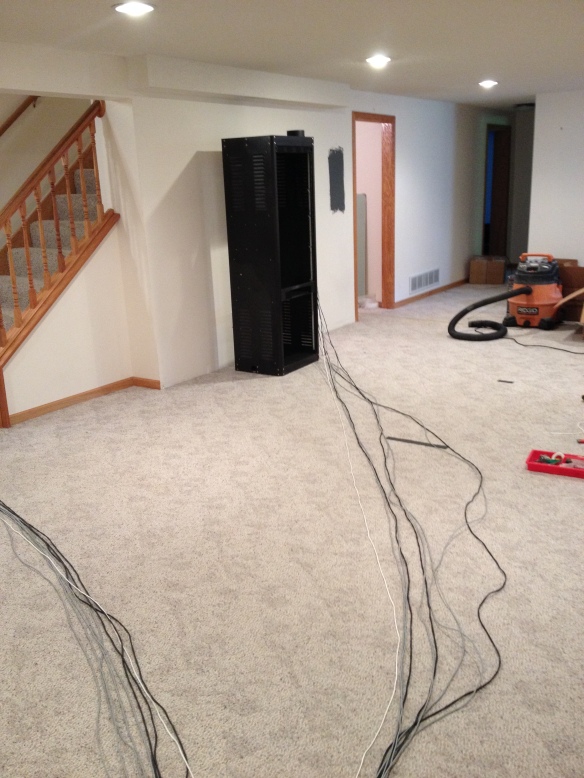Home Theater Nerd loves film! See, I just made Sister Claire, my eighth grade English teacher upset by referring to myself in the third person in an effort to put special emphasis on this point. Also, I’m not talking about “movies in general” here, I mean actual film. So, I’ll say it again in another way “Home Theater Nerd loves celluloid”. It may be easy to think that I’m easily swept up in all this new technology but the truth is that cinema as we have known it for the past 100 years is changing, and not necessarily for the better. So I figured I would take this post to share a few bits of trivia and history on film as a means of exhibition and talk about where we are headed.
First off, film has been around for a long time. Most folks don’t realize how dangerous and complex film projection was prior to the second World War. At that time, almost all 35 film was produced on nitrate film stock which had a similar kind of chemical composition as nitroglycerin. The film itself was highly flammable, so much in fact, that it will burn under water! On top of that projectors didn’t use xenon lamps, they had carbon arc lamps. A carbon arc lamp is essentially a welding torch burning away at a couple thousand degrees to produce light. All of this, mere inches away from the nitrate film stock. Now projectionists were highly trained union professionals, and projectors had some safeguards built in as well. On top of this, the projection booth was fire lined, the portholes had fire shutters, and the booth even had an escape hatch! The hope is that if it started on fire, they could seal up the booth and save the rest of the theater. There was a good reason why you never yelled “fire” in a crowded theater, and if you want to see a realistic example of this danger watch the movie “Cinema Paradisio”.

Early 20th century film projection booth designed for Nitrate film.
Granted they refined film stocks, they created new processes to introduce color, increase visual fidelity and produce multi-channel surround sound. I won’t hit on all of that in this post. Needless to say, we saw things like 3-strip Technicolor, 65mm Todd-AO, Vistavision. Now, I’m probably not the guy to give a history lesson on all of this technology, but it is fascinating in my opinion. Maybe I can throw up some links in a later post.
The take away here, is that until recently, and still in many ways, film surpasses digital in some areas of performance. With the exception of a handful or brand new cameras, film had a much greater dynamic range. This is in reference to the amount of steps you have between light and dark. I have also read that 35mm film is roughly the equivalent of 6000 horizontal lines of resolution or “6K” digital resolution, when it leaves the camera. When projected, 35mm film still has the capability of being close to 4K in horizontal resolution (although it rarely does anymore). Now 70mm IMAX film would leave the camera with the equivalent of 18,000 lines of horizontal resolution and was projected at a resolution equivalent of roughly 12,000 lines or 12K! So in terms of resolution we are close to being able to offer a descent replacement to 35mm projection with 4K resolution displays now. But with true 70mm IMAX, nothing else exists that comes near it in terms of resolution or fidelity. Newer is not necessarily better.
So this brings the discussion to IMAX. First of all, true IMAX as we grew up knowing it is awesome. It is the pinnacle of film technology. IMAX essentially took standard Kodak 5 perf 70mm film stock(perferations being the amount of sprocket holes used to advance the film per frame), rotated it 90 degrees so it goes through the camera and projector horizontally, using 15 perforations per frame (which is why it is often referred to as 15 perf 70mm). This gave each frame much more picture information allowing IMAX to push screen sizes up to seven stories high while maintaining incredible clarity.

The problem is that IMAX originally had a pretty small target market for many years. Using just a handful of cameras they created only museum documentaries for years. However as the amount of IMAX theaters grew they found the need to diversify in to Hollywood movies to cover rising costs of prints. A single IMAX film print costs as much as a new car, and 3D doubles the price.
Soon IMAX found itself in the digital cinema exhibition business as well. These IMAX theaters were not the 15-perf 70mm monsters that we saw built in the 80’s but just very large theaters within your typical multiplex They were differentiated from normal theaters by stadium seating, very bright digital projection and powerful sound. My first time seeing one was for the 2009 Star Trek reboot and I was actually very impressed. It did offer several advantages over the 35mm screens near my home. No film jutter, no dust, no worn prints, incredible brightness. I still think they are an excellent way to watch a new movie in a theatrical setting. It however was not the same IMAX experience I remember as a child. In short, it wasn’t nearly large enough.

IMAX at your local Cineplex vs. traditional 70mm IMAX
So as of today, IMAX has a mix of digital IMAX theaters with smaller screens as well as their less common traditional large format 15-perf 70mm theaters. My only gripe is that IMAX never differentiated them in name or advertising. Growing frustration over this difference caused many on the net to refer to these smaller IMAX screens as “LieMax”. I once heard that they responded to this criticism in stating that referring to the small theaters as having “digital” in the name may give the impression to many theater goers that they are better than the traditional large format 70mm theaters. I think that is actually a fair point, so I cut them some slack.
The sad news is that IMAX will soon be replacing the 15-perf 70mm projectors on even their biggest screens with digital projection. Industry folks have stated that the new digital projectors will be brighter as they utilize laser based projectors rather than a xenon lamp. They are also quick to point out that once a film is edited digitally it is essentially stripped of any resolution above 4K anyway. So this transition probably won’t result in a major loss in quality. Infact in some ways it may be better. Unfortunately it still relies on 4K projectors, with nearly the same resolution as what can be filmed on a GoPro4 and shown right now in your living room. So admittedly, I’m cautious, and yet very curious to see the result. Personally I think digital camera technology is advancing much faster than our exhibition technology in terms of resolution and color reproduction.
Unfortunately, when the last film based IMAX projector is carted away we will really see the end of film based projection in theaters. It will be the end of the era, as nearly all 35mm theaters in the United States have already made the conversion to digital.
So with that, I tell you go out and see Christopher Nolan’s Interstellar on a large screen 15-perf 70mm IMAX screen. It was shot on film, it is in 2D, the screen will be massive. Digital technologies will continue to improve but I for one am eager to see this pinnacle of film technology shown one last time, in 2D no less! I’m hoping to remember it as a benchmark to which all future technology releases can be compared to.



































